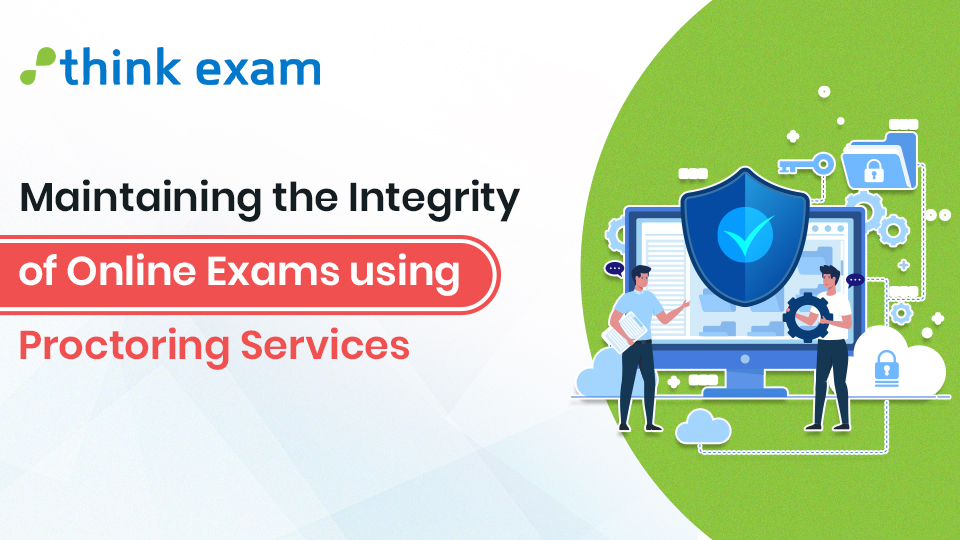We live in an era where technology has added innovation in delivering secure assessments. “There was an incident in Singapore with a 17-year-old student who voluntarily continued to cough and tried to distract the invigilator while cheating through the earphones.” Now the online assessment domain is not outdated to be fooled by such attempts, and the only technology that enhances the authenticity of online assessment is the online exam proctoring service.
Features to maintain the Integrity of Online Exams using Proctoring Services are:
- – Authentication of the candidate
- – Audio-video live broadcast, as well as recording
- – AI features for detecting suspicious actions or behaviors
- – Restriction of browsing
- – Screen freeze feature
- – Constant monitoring of the webcam, etc.
What is Online Proctoring Service?
Online proctoring services gives candidates the right to take the exam remotely, regardless of geographical restrictions. To proctor these examinations online monitoring software is used to ensure that the examination is free of fraud. There are mainly three different types of Online exam proctoring service which are given below:
1. Subsequent Proctoring – In subsequent proctoring, the pictures are constantly taken and the video is recorded. The photos and videos will then be reviewed by the proctor to identify cases of fraud, if any during the ongoing exam.
2. Live Proctoring – As the name suggests, in live proctoring, the proctor examines the exam in real time. If any fraud is detected, the proctor can intervene and even cancel the exam after raising the red flags.
3. Automatic Proctoring – Instead of a human, a proctoring tool is used to detect various movements on the screen. If the applicant is suspected of replacing the test screen or using other tabs, the software will automatically raise issues.
How Does Remote Proctoring Work?
Let’s take a look at how online exam proctoring services work.
Step 1 – Candidate appearing for the test needs to fill in the mandatory fields available on the screen such as the candidate’s Name, Date of Birth, Age, Gender and University.
Step 2 – Next, the candidate needs to prove his / her identity by providing any identification proof, which is confirmed by a face recognition feature integrated in Proctoring tools. At this stage, even the webcam and microphone are tested to fix any errors or malfunctions.
Step 3 – Now the evaluation will start and the computer’s webcam will be turned on to monitor the candidate during the exam.
Step 4 – Proctored exams have a chat box option through which the proctor can pass any additional information to the candidates if necessary.
Step 5 – If the candidate does any suspicious activity, then the proctoring tool will raise the “automatic behavior warning” alarm. Once the warning has been raised for any student, then the proctor will decide on what further action is required.
Step 6 – The timing of the online exam is set and the assessment gets submitted automatically after the time out.
Step 7 – In the final stage of the proctored examinations, the candidate is provided with a detailed exam report, which consists of a detailed question wise analysis.
The proctor can see all candidates at once through grid view or select individual screens to see each single candidate’s movement. The other window provides a detailed view of all the tabs that the candidate opens on the device.
What is the need for an online exam using proctoring service?
Online proctoring has taken us all the way from manual to fast remote invigilation. It has taken our pen and paper-based assessments to an automated level with online exam proctoring service. E-learning adoptions are growing day by day, and the demand is influenced by various factors and a detailed understanding of these factors will help you better understand the need for online proctoring.
1. Cheating
According to a survey by the International Center for Academic Integrity, “70 percent of college students have confirmed that they cheated during exams.” Cheating is an unavoidable factor in any exam and can only be countered with intelligent automation methods.
Online proctoring is the most effective way to reduce the cheating percentage in an exam. If a person knows that he is being observed, then it is psychologically proven that the probability of unlikely actions automatically decreases.
2. Economical and Saves Time
“It is estimated that remote proctoring can save up to 25% of expense on each exam”
Traditional assessments require the involvement of a group of invigilators, as well as pre-planning for logistics, which is an additional stress in conducting exams. With online proctoring, you can reduce the stress factor by eliminating the logistics and saving manual evaluation time.
3. Availability of a Wide Range of Options
Virtual Proctoring consists of several options like 360-degree video, audio surveillance and live video recording using the webcam.
Conclusion
The future of online proctoring has many benefits and many scopes for users. This is already accepted by various industries and sectors around the world, and this confirms the credibility in the world of online assessment. Online exam proctoring service is known for its flexibility, affordability, and quality to save time, which is a must for any test creator / administrator to adopt the technology they need.








